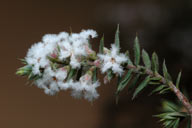In Flower This Week
A news sheet prepared by a Gardens' volunteer.
Numbers before each plant refer to temporary IFTW labels in the gardens.
Numbers in square brackets [ ] refer to garden bed Sections. Plants in flower are in bold type.
View past issues of 'In Flower This Week'.
22 July 2015
Leucopogon attenuatus click for larger image |
Today’s walk is along the main path to explore the Banks Loop.
- Outside the Visitor Information Centre is Banksia calophylla [Section 174]. Endemic to Western Australia, it has stiff, saw-toothed leaves, with partly-concealed orange to red flowers. This is a great example of the diversity of the genus Banksia.
- On the right as you walk along the Main Path is Darwinia macrostegia [Section 174]. It is a small shrub with red and white flowers, which are opening to reveal their attractive bell shapes. This plant is found close to Albany in Western Australia with five populations in Stirling Range National Park.
- In a pot on the right is Leucopogon attenuatus [Section 174], a small shrub with tiny white flowers. Found in the ACT in forest and grassy areas, in eastern New South Wales from the Queensland border, and in Victoria where it is classified as rare.
- Also on your right is Epacris impressa [Section 174], a straggly bush with bright pink tubular flowers that have indentations at the base. This pink-flowered form is the state floral emblem of Victoria.
- At the end of Banks Walk on your right is Chamelaucium ‘Cascade Jewel ’[Section 174]. It has drooping branches and unusually large pink flowers with darker pink centres.
- Walk on past the café and on your left is Eucalyptus gregsoniana [Section 131], with a grey trunk and white fluffy flowers. The Mallee Snow Gum, as it is also known, is found in the highlands of New South Wales.
- Also on your left is Epacris longiflora [Section 131], with thin tubular red and white flowers on a light green bush. Its native range extends from the central coast of New South Wales to southern Queensland. Nearby is a cultivar derived from this species, Epacris ‘Nectar Pink’.
- Follow the Main Path to the major junction and take the lower path above the Banks Building. On your left is Homoranthus flavescens [Section 143], with silver to blue-grey leaves on spreading horizontal branches. The flowers are yellow and have an unusual scent.
- Adjacent is Pimelea latifolia [Section 143], with unobtrusive white flowers.
- On your right is Banksia ‘Giant Candles’ [Section 310], a large shrub that can grow up to five metres. It is known for its large bronzy-orange flower spikes, which are showy from late autumn through winter and attract many birds.
- Further along on your left is Grevillea floribunda [Section 143], a small shrub with attractive light green and yellow flowers. Its range is from central New South Wales to Queensland, west of the ranges. Nearby is Grevillea ‘Lady O’ with contrasting flowers.
- Continue on in a clockwise direction around the loop and you will find a group of banksias on your left with contrasting foliage, flower colour and growth habit, including Banksia spinulosa [Section 306].
- Return to the intersection with the main path and take the uphill route past the Master Plan sign. Turn second left and walk along this road towards the rainforest. On your left is Acacia podalyrifolia [Section 126], a tall silver-grey shrub or small tree also known as the Queensland Silver Wattle. It produces round golden flower heads during winter.
- As you turn the corner there are a number of plants of Grevillea ‘Rosy Posy’ [Section 128]. Birds love the large sprays of pink and cream flowers that give this cultivar its name. It was developed by Austraflora Nurseries in Victoria.
- Adjacent is Acacia siculiformis [Section 128], an erect prickly shrub with the common name of Dagger Wattle. It is a frost-tolerant plant with yellow flower heads that attract birds.
Rosalind Walcott
![Director of National Parks [logo]](../../../../images/dnp_90px.gif)







